In July of 1884, Maryland historian J. Thomas Scharf conducted a search of the old Treasury Building located on State Circle in Annapolis. The Treasury Building was constructed in 1735-36 and is the oldest public building in Annapolis, as seen here. In the 1800s, it became a storehouse for colonial and later records of the state; a formal state archive was not established until 1935. Those irreplaceable, but carelessly stored papers were finally saved in the late 1880s by Scharf and the Maryland Historical Society, eventually becoming the historic core of the State Archives. Among the clutter of boxes, decaying documents and rodent droppings, the searchers discovered something truly remarkable and of tremendous significance – the long forgotten Great Seal of Maryland. It was a direct link to the 17th-century colony and the Lords Baltimore.
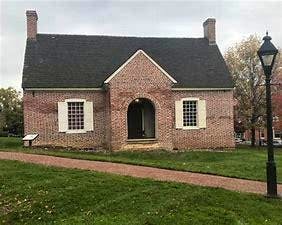 The Old Treasury Building near the State House in Annapolis, built in 1735-36
The Old Treasury Building near the State House in Annapolis, built in 1735-36
The use of seals is of ancient vintage, being widely employed in the Ancient world and continuing up to the present day. Seals serve as official devices of Bishops, Princes and Kings to signify their authority, approval, and sovereignty over an action, political entity and/or territory. This tradition was followed by the Lords Baltimore who issued a formal “Great Seal” for their colonial endeavors. Note that there are also personal seals (signet rings or stamps) that serve as one’s official mark and they will be discussed in a subsequent article.
The Maryland seal is caste in silver and of two parts, as can be seen here. The correct term for the pair is actually a seal matrix, from which the wax seal is made. Both are just under 4 inches in diameter. The left specimen is the front or obverse of the seal and the right one the reverse or counterseal. The right side would have been fixed in position with a holder from which four stout wires or similar projections extended, and hot wax poured on it. Then a piece of ribbon or thin ropes would be placed over the center of the waxed area and extending beyond it on both sides. Next, hot wax would be poured to fill the holder, the front side fitted over the projections using the four “ears, and it rapidly pushed down to impress the image
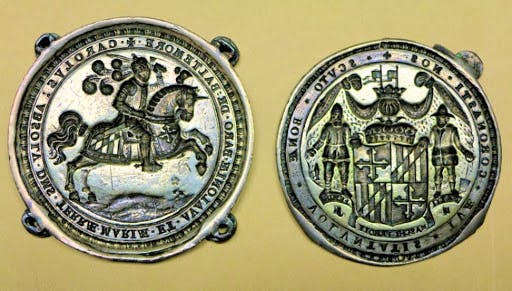 The two sides of the 17th-century Great Seal of Maryland, in possession of the Maryland State Archives
The two sides of the 17th-century Great Seal of Maryland, in possession of the Maryland State Archives
The purpose of the ribbon or rope is to allow the wax seal to be securely affixes to the document it is authorizing. With time, the two items tend to become separated. An excellent surviving example which is still fully intact is the grant for Tisbury Manor given to the Second Lord Arundell of Wardour (Anne Arundell’s brother) by King Charles I in 1641. The Great Seal of England is attached with a twisted two-color rope cord. A wax Maryland Great Seal would likewise have had a cord or thick ribbon running through it for the same purpose.
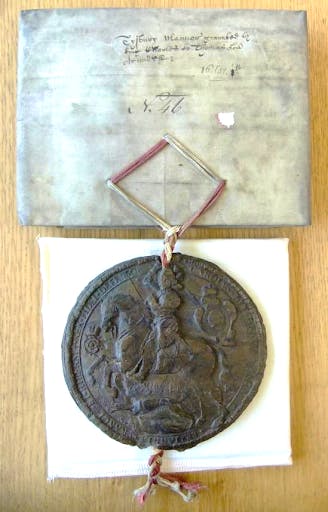 A 1641 Manorial Grant issued by King Charles I which has the original Great Seal of England still attached to the Document with colored rope. This is in the possession of the Wiltshire and Swindon History Centre in Chippenham, Wiltshire, England.
A 1641 Manorial Grant issued by King Charles I which has the original Great Seal of England still attached to the Document with colored rope. This is in the possession of the Wiltshire and Swindon History Centre in Chippenham, Wiltshire, England.
Cecil Calvert recognized the need for such a tool of government and we actually have his explanation for it. In 1648, he wrote that
“… it is necessary for the better Government of our said Province and Satisfaction of the People there to have a Seal of ours Constantly remaining in the said Province and appropriated thereunto and known to be our Great Seal of the same whereby divers publick Acts and Grants of Lands within the said Province may be ratified and Confirmed”( Maryland Archives 3: 214)
But how do you create a Great Seal? A key reference point would have been the royal seals of the monarchy. The oldest surviving example in England is from the last Anglo-Saxon King Edward the Confessor, who died in 1066. His and subsequent Great Seals of English monarchs are consistently round and of two parts known as a seal and counterseal. One face shows the regal person mounted on a horse and the other seated on a throne holding the orb and scepter, symbols of their authority. The front of Charles 1 Great Seal with him on horseback is seen above. Another very important design source would have been medieval heraldry. It appears that the Lords Baltimore were aware of the importance of symbolism on such a highly important device and consulted with experts in heraldry in the design of the official seal for their colony.
The Great Seal of Maryland was designed between late June 1632 after the Charter was granted and the autumn of 1633, when it was sent with the first expedition to establish Maryland. But the original seal was used for only 11 years. In 1645, Richard Ingle attacked the young colony, captured it and took the seal. Given its precious metal composition, he probably melted it down both for its value and to destroy the symbol of Lord Baltimore’s government. Once control of the colony was reestablished, Lord Baltimore had another seal produced and it was sent to Maryland in 1648. It was very similar to the original and Baltimore gave a full description of it that can be found in the Archives of Maryland, Volume 3: 214-215. He wrote that
“…the figure of the Seal is round and it is of the same Bigness that our said former Great Seal was and cut in Silver as the other was the impression of all which in wax is hereunto affixed it being somewhat different (though but little) from our said former Great Seal of the said Province…”.
It is this second seal that Scharf found in the 1884 search and I have had the privilege of examining and photographing at the Archives. It matches precisely the 1648 description Calvert wrote. I have been unable to locate any wax seals that were struck with the original seal. With this background in mind, let use examine the nature of each side of the Great Seal and try to infer the meaning Lord Baltimore intended in its design.
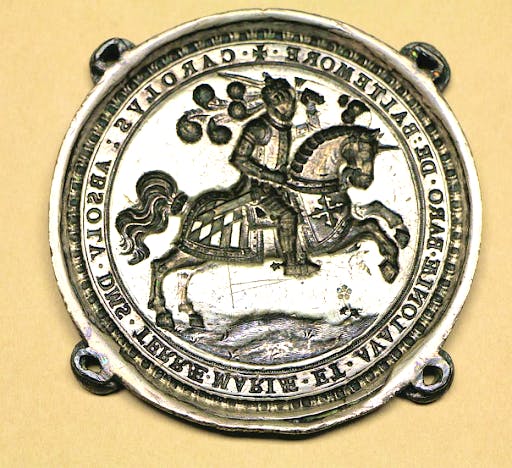 The Front or Obverse Side
The Front or Obverse Side
This face shows Lord Baltimore mounted on a charging horse. He is wearing full armor with a raised sword and plumes extending from his helmet. The galloping horse itself is wearing caparison or clothing that displays the Calvert family coat-of-arms. He rides along a beach from which a bit of grass and a single five petal flower grows. Also note that he is wearing a coronet (Earl’s Crown) atop the helmet, surmounted by an orb, a symbol of authority. A coronet was not allowed for a baron, so why does it appear here? The answer is a clause in the Maryland charter, no doubt added by George Calvert, stating that he will have all the powers the Bishop of Durham had or should have had in his palatinate. Maryland was given the designation of a Palatinate which meant it could be ruled with nearly kingly powers. This is what made the coronet allowable on the Great Seal. It can be interpreted as a statement of Calvert’s princely power over the province of Maryland, for he is defined in the charter as the “True and absolute Lord and Proprietor”. The legend around the border is in Latin can be translated as “Charles Absolute Dominion of Maryland and Avalon, Baron of Baltimore”. The original had Cecil’s name but when Charles inherited the title and colony at Cecil’s death in 1675, he had the seal altered to display his name. It refers to both Maryland and the colony of Avalon in Newfoundland because the Calverts possessed both colonies in 1633.
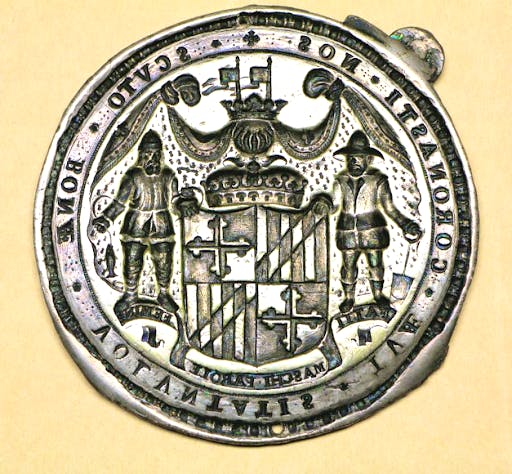 The Reverse or Counterseal Side
The Reverse or Counterseal Side
This side is dominated by the Calvert family crest on a quartered shield. Two sections have the cross hatched Calvert family insignia and the other two the Cross-Botany insignia of the Crossland and/or the Mynne families. While not conclusive, there is a suggestion from heraldry that the vertical lines (black and gold portions on the state flag) represent palisades showing the ability to protect or defend a place and the thinner line running from lower left to top right on both sections represents a sword belt. The cross-botany symbolized the Christian warrior, and the three lobes at the end of each arm can represent the Holy Trinity. Alternatively, they can also be interpreted as floral buds of virtue coming into bloom and full of promise.
On the Great Seal, the family coat-of-arms is topped with the Earl’s cornet representing the palatinate status of the colony, as seen here. Cecil Calvert himself identifies this as “Count Palatine Cap”. (Note that a Count and an Earl are the same rank, but England continued using the older Anglo-Saxon term Earl instead of the Continental one of a Count).

The lower crown has five strawberry leaves with six balls called pearls between them, six is the number for a baron. At its center is an orb and cross of regal authority. Above the cornet is a barred helmet facing the viewer and capped with a smaller crown. Only the upper nobility were allowed to use either open helmets or barred helmets on seals, with lesser nobles have closed ones. This became an English practice around 1615, according to some heraldry sources, indicating Lord Baltimore was attune to fashionable ideas. The helmet facing the viewer is indicative of the ability to exercise governance over a state, but also a feudal allusion of the knight facing his superior and paying allegiance to his liege. This is significant because normally a Baron’s helmet would be facing to one side, but this symbolizes the unique authority provided by the royal charter for Maryland, while still owing loyalty to the English king. Two pennons or pennants arise from the top cornet. They have a swallow-tailed form, called an banderole. Such banners were carried by knights but also used by monarchs to designate their headquarters or seat of authority. I have not yet been able to decipher the meaning of having two banderoles on this crest.
On either side of the quartered shield are supporters. On Lord Baltimore’s Baronial crest, these are leopards, but they were changed for the colony. They are two males, one a planter or farmer and the other a fisherman, representing the chief industries of the Lords Baltimore’s two American colonies – Maryland and Avalon. It is likely that Calvert intended for this seal design to be applicable to both colonies. However, he gradually lost control of Newfoundland in the 1660s, despite the efforts of Lord Baltimore to retain it.
Under the shield is the motto George Calvert selected after he became a knight and could obtained a formal crest. It is derived from an ancient Italian proverb – “Fatti Machii Parole Femine”. This can be interpreted in several ways and has occasionally been a matter of controversy. A widely accepted translation is “Manly Deeds, Womanly Words”, although “Strong Deeds, Gentle Words” is another version. This motto was selected at the time George Calvert was running important aspects of the foreign affair for the kingdom of England. That is an essential context when attempting to evaluate the intended meaning of this choice. A 17th-century English observer would likely interpret this phrase on the crest as meaning courage and courtesy are our virtues, something very appropriate for a person at the very center of England’s diplomatic affairs.
Bordering the reverse side is a Latin phrase from the Bible that is translated “With favor you cover him as with a shield”. This is taken from the 12th verse of the 5th Psalm and the full sentence reads “For you bless the righteous, O Lord; with favor you cover him as with a shield”. This may have been intended to invoke divine assistance with and protection of the Maryland enterprise. Behind the shield and supporters is a cloak or robe that is lined with ermine, which was usually associated with royalty and high-ranking peers in heraldry. And at the top on both sides of the seal is a tiny cross. The form is called a cross pattée that has long been associated with Christian monarchy.
The Great Seal of Maryland is very rich in meaning. It symbolizes authority and was an essential instrument for governance in the colony and now the state. Although the Lords Baltimore lost control of the colony in 1689, they retained the rights to land and the Great Seal continued to be used to certify land patents. In 1874, the design of the 17th-century Great Seal was officially adopted by the State of Maryland, and with some modifications, it continues in use today. Maryland is one of the few states with an official double-sided seal, although the Reverse side is the one normally used on official documents.
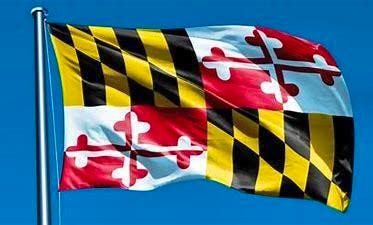
Today, Maryland is the only state whose seal and flag are based exclusively upon medieval heraldry and also the oldest, precisely dated to the year 1633. It is the most distinctive and ancient of any State’s symbolism and truly the foundation to Maryland iconography and identity, appearing on the flag and official decrees, license plates, football team uniforms, hats and scarfs, and even crab motifs. The Great Seal is the single most powerful expression of Maryland’s deep and vibrant heritage
About the Author
Dr. Miller is a Historical Archaeologist who received a B. A. degree in Anthropology from the University of Arkansas. He subsequently received an M.A. and Ph.D. in Anthropology from Michigan State University with a specialization in historic sites archaeology. Dr. Miller began his time with HSMC in 1972 when he was hired as an archaeological excavator. Miller has spent much of his career exploring 17th-century sites and the conversion of those into public exhibits, both in galleries and as full reconstructions. In January 2020, Dr. Miller was awarded the J.C. Harrington Medal in Historical Archaeology in recognition of a lifetime of contributions to the field.
